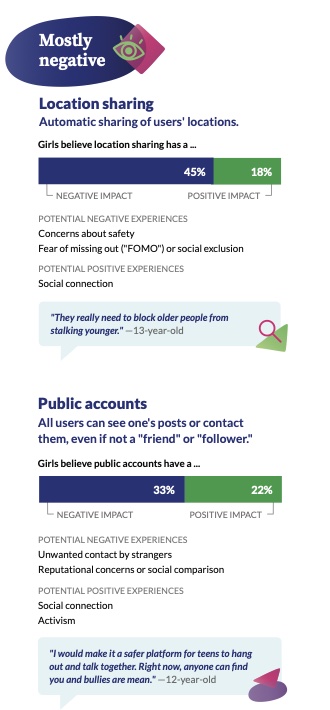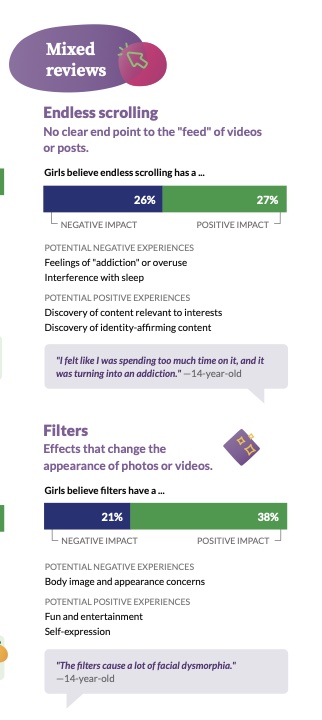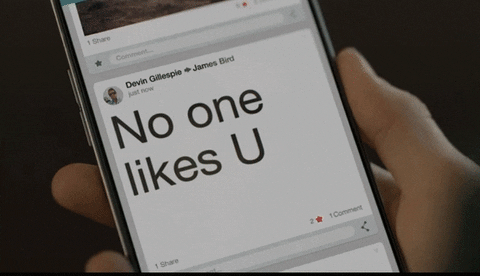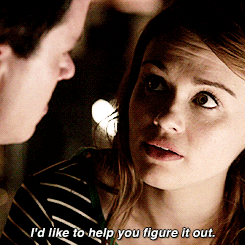Is it Enough? Social Media Platforms Limit Screen Time for Teens

Social media has become an incredibly important part of our daily lives, particularly among teenagers.
There are numerous social media platforms available for young people to connect and share their thoughts, photos, and videos with the world, ranging from Instagram to TikTok, Snapchat to Twitter.
However, as social media platforms continue to evolve and dominate our digital landscape, teenagers attitudes toward them are changing.
Teenagers are becoming increasingly aware of the negative impact social media can have on their mental health, which is one of the most significant changes in recent years.
For example, Common Sense Media recently published research on teen girls' experiences on TikTok, Facebook, Snapchat, Instagram, and YouTube highlights how platforms can better protect their mental health.
They found that no single platform stood out as being worse than another when it comes to teen girls' mental health. Instead, specific features stood out in both positive and negative ways. The features that make these platforms most engaging and successful are also the ones that can have negative impacts on teen girls. Location sharing (45%) and public accounts (33%) were the features that girls said had the most negative impact. These universal features and the impact they have on teen girls are some of the important changes that need to be made on social media platforms.


While social media was once thought to be a fun and harmless way to stay in touch with friends and family, many young people now regard it as a source of anxiety, stress, and pressure.
According to a 2019 Pew Research Center survey, 70% of teens see anxiety and depression as major problems among their peers, and 57% believe that social media use contributes to these issues.
Perhaps it is safe to say this is an attempt not just to address a potential ban of the platform, but also the impacts of social media on youth mental health: Both the U.S. surgeon general and CDC have recognized kids' mental health as a critical issue, especially for teen girls.
A daily screen time limit of 60 minute will be automatically applied to every TikTok user under 18 years old. The feature can be disabled completely or a passcode could pop up to continue watching.
While there's no collectively-endorsed position on how much screen time is 'too much', it is nice to see the media companies put more parental controls and limits in place. Especially since they were so instrumental in making the platform difficult to leave.
Four additional new features are also being added to Family Pairing, TikTok's customizable parental controls that allow a parent or guardian to link their TikTok account to a younger user's account.
Custom limits can be applied, allowing restrictions to be adjusted based on what day of the week it is or more widely extended over school holidays.
Parents can also see a screen time dashboard and have the ability to mute TikTok notifications on their child's device.
But will this be enough?
Despite concerns, teenagers continue to use social media on a regular basis. Indeed, social media has become an essential tool for many young people to communicate with others and build relationships.
Snapchat and Instagram allow teens to share photos and videos with their friends and followers, whereas Twitter and TikTok allow them to participate in global conversations and trends.
While social media can be a positive force for connection, it also has drawbacks.

Cyberbullying, for example, is a serious problem that affects a large number of young people on social media. According to a 2020 Pew Research Center study, 59% of teenagers have experienced some form of cyberbullying, and
42% have experienced it in the last year alone.
Another issue that teens are concerned about is the impact of social media on their self-esteem and body image.
Many young people feel pressure to present themselves in a certain way on social media, whether that means curating the perfect Instagram feed or altering their appearance with filters and editing tools.
This can lead to feelings of inadequacy and self-doubt, especially when comparing their lives to those of influencers and celebrities who appear to have it all together.
Despite these obstacles, teenagers can take steps to use social media in a healthy and positive manner.
Setting social media usage limits, unfollowing accounts that make them feel bad about themselves, and focusing on real-life relationships, for example, can all help to mitigate the negative effects of social media.
Ultimately, social media has become a double-edged sword for teenagers.
While it has many advantages, such as the ability to connect with others and share their experiences with the rest of the world, it also has significant risks.
As time goes on, it's critical that young people are aware of these risks and take
steps to use social media in a healthy and positive manner.
Here are some of the most important findings:
- Instant gratification: Social media platforms offer immediate gratification, which is particularly appealing to teenagers. Likes, comments, and followers can provide instant validation and boost self-esteem.
- Fear of missing out (FOMO): Teens often feel the need to stay connected with their peers and be aware of the latest trends and events. Social media allows them to stay in the loop and avoid
feeling left out. - Escapism: Social media can provide an escape from the stresses of everyday life. Many teenagers use social media to relax and unwind, often spending hours scrolling through their feeds.
- Social comparison: Social media allows teens to compare themselves to others, which can lead to feelings of inadequacy and self-doubt. However, it can also provide a sense of belonging when they see others with similar interests or experiences.
- Dopamine rush: Social media triggers the release of dopamine, a neurotransmitter associated with pleasure and reward. The anticipation of receiving likes or comments can create a dopamine rush that can be addictive.
- Peer pressure: Many teens feel pressure to be on social media platforms, especially if their friends are using them. They may fear being left out or ostracized if they do not participate.
- Marketing strategies: Social media companies use sophisticated marketing strategies to keep users engaged and addicted to their platforms. For example, algorithms that suggest content based on a users interests can keep them scrolling for hours.
These are just some of the reasons why teens can become addicted to social media platforms. It's important to note that addiction is a complex issue and can have serious consequences on mental health and overall wellbeing.

Here’s what we can do to help teens:
- Be Curious, not judgmental. Ask your children about their experiences with media and tech to build trust and connection instead of telling them how bad it is all the time.
- Encourage other activities: Encourage teens to engage in other activities that they enjoy, such as sports, hobbies, or spending time with friends and family. These activities can provide a healthy outlet and help reduce their dependence on social media.
- Create tech-free zones: Encourage teens to set aside tech-free zones, such as meal times or an hour before bed, where they can disconnect from social media and other technology.
- Set limits/Teach balance: Encourage teens to set limits on their social media use. This can include setting a time limit for each session or limiting social media use to a certain number of times per day. Let technology do this for you. You don't have to be the bad guy.
- Model healthy tech habits: Parents and other adults can model healthy tech habits by limiting their own social media use and engaging in other activities. This can help set a positive example for teens.
- Attend a social media or internet safety course: We happen to offer an online self-paced E-course or get a small group together for a live or virtual live program. This ensures these important conversations happen comprehensively.
- Encourage face-to-face communication: Encourage teens to engage in face-to-face communication with friends and family, rather than relying solely on social media to stay connected.
- Promote self-awareness: Encourage teens to be self-aware of their social media use and the impact it may have on their mental health and wellbeing. This can include encouraging them to take breaks from social media when they are feeling overwhelmed or anxious.
- Seek professional help: If social media use becomes a serious problem, seek professional help from a therapist or counselor who can provide support and guidance on healthy social media use.
Remember, it's important to approach this issue with empathy and understanding. Social media addiction can be a complex issue, and its important to support teens in finding a healthy balance between social media use and other activities.

